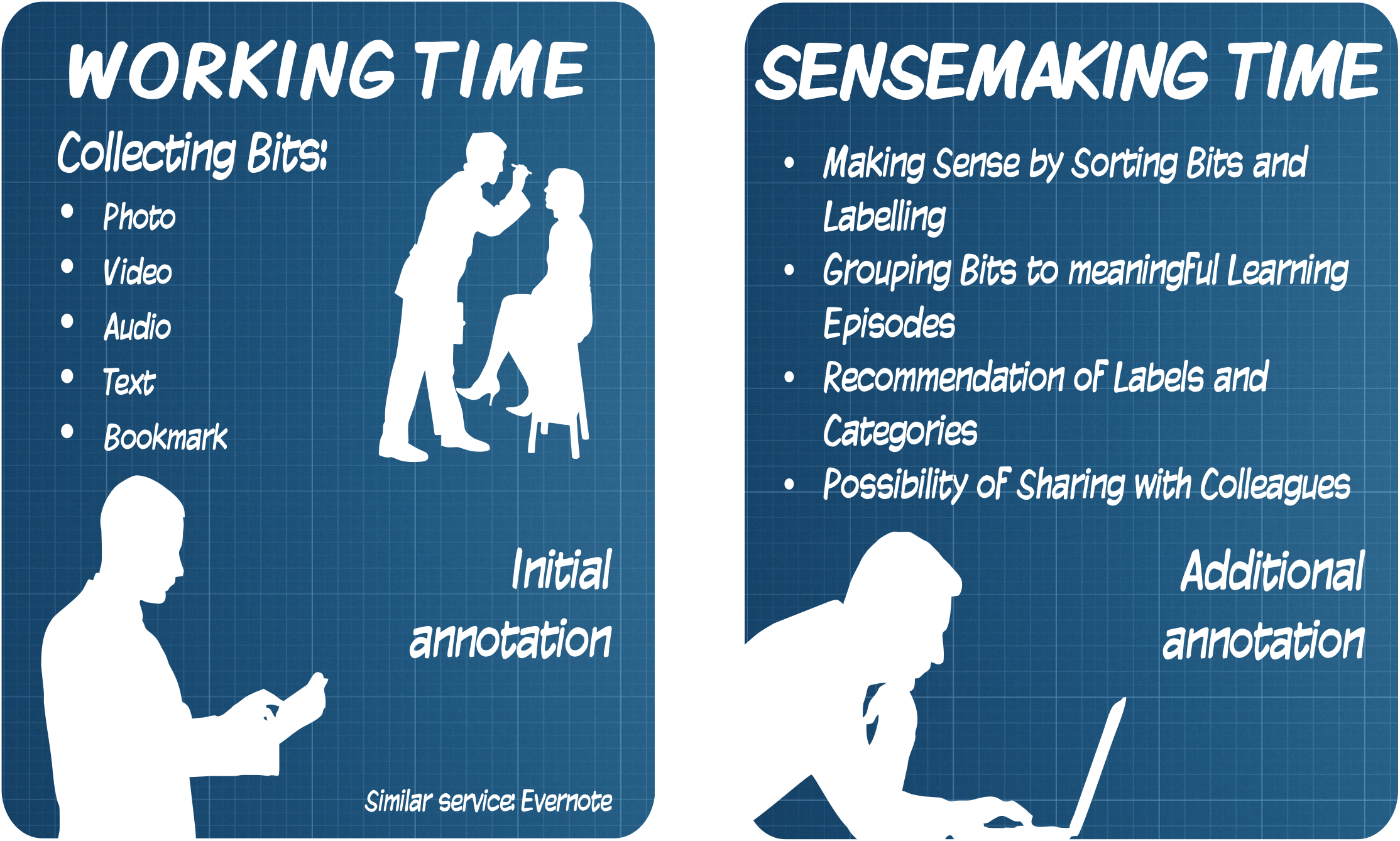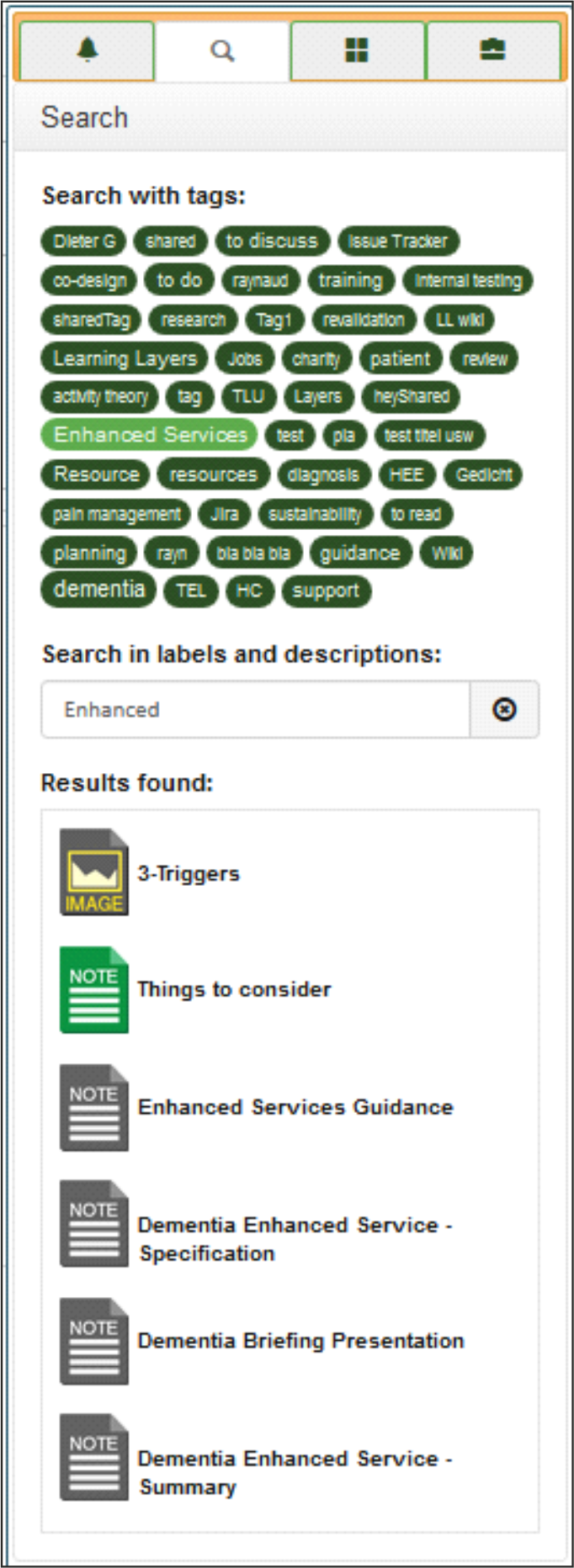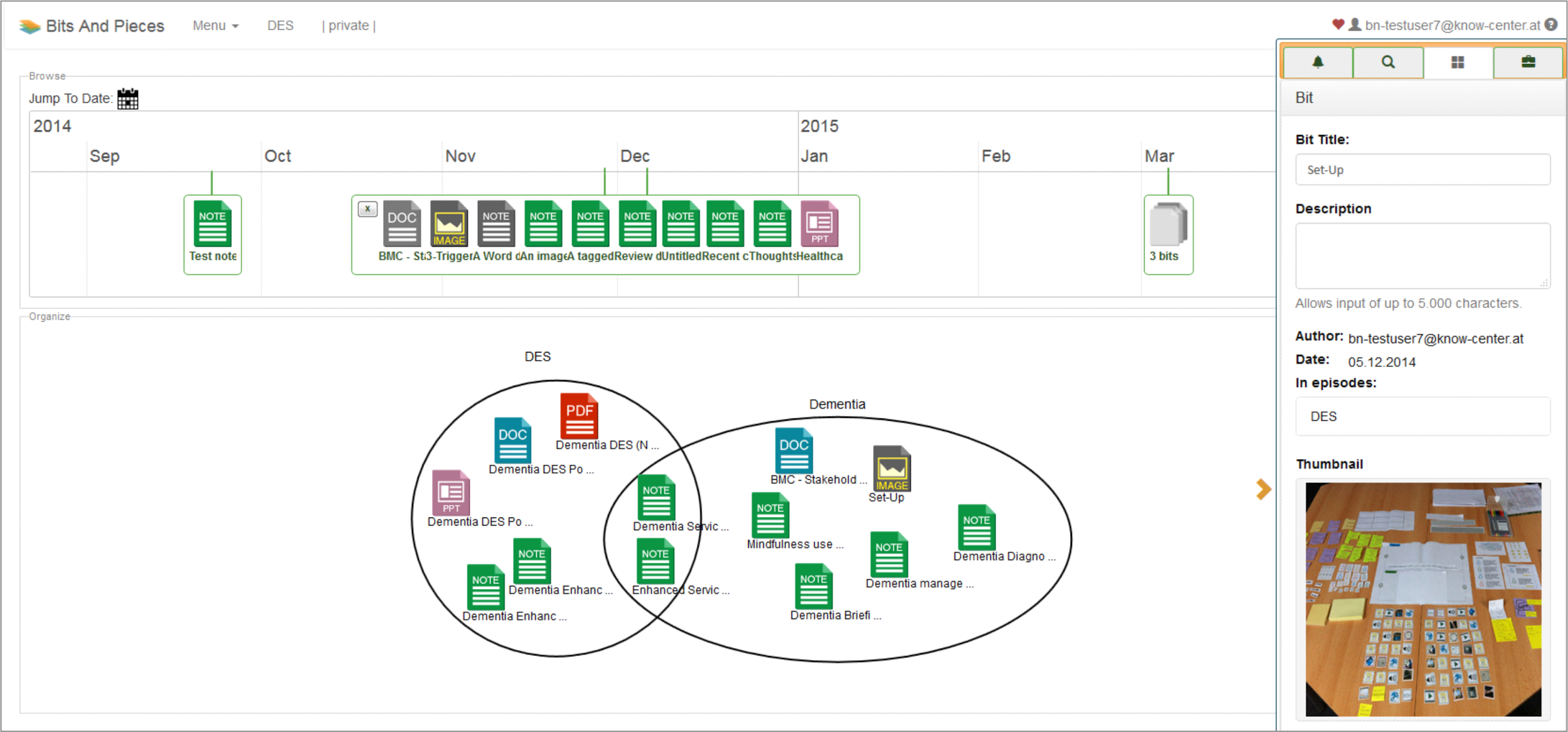Bits and Pieces (B&P) is a novel sensemaking interface for healthcare professionals’ informal learning, i.e., self-regulated individual and collaborative learning at the workplace. First, B&P supports remembering of informal learning experiences based on records, so called bits and pieces of information, that the professionals recorded in the moment of experience by making a photo or writing a quick note with collection tools such as Evernote These bits contain episodic and/or semantic cues and serve as memory aids for recalling the original experience. Afterwards, the tool supports making sense of those bits to elaborate on the former informal learning experiences and convert them into actionable knowledge that can be directly applied in practice.
Recall records of informal learning experiences
Narrow the collected records down with respect to a certain issue
Relate the respective experiences to each other via a visual, iterative approach to sensemaking
Feature list
Overall, B&P provides features for healthcare professionals to recall records of informal learning experiences, i.e., bits and pieces of information, based on episodic and semantic cues, narrow them down with respect to a certain issue and then, individually or collaboratively relate the respective experiences to each other via a visual, iterative approach to sensemaking.

The tool is a front-end application, which is connected to the back-end application named SocialSemanticServer (SSS). It represents an extensible, open-source application server environment that equips client-side tools and back-end applications with services to support and scale informal learning at the workplace. Based on these services, B&P imports bits and pieces from different sources or collection services into SSS service firsts. Currently, bits are collected with either Email in or Evernote. If the tool offers the chance for reflection in form of labelling and tagging bits such as in Evernote, respective information will be integrated into B&P as well.
After importing bits, B&P supports contextual recalling informal learning experiences via time based cues to represent episodic information or topic/ tag-based search to represent semantic information. While the episodic information is depicted in a form of a zoomable timeline that allows to navigate experiences departing from a coarse month to a detailed hour dimension, the semantic information is depicted in form of a tag cloud that allows to combine different topics by ‘and’ search operators. Depending on the chance for reflecting about the experience in the moment of recording (Sensemaking and Meaning Making in Informal Workplace Learning) either the time or topics based cues will help to rediscover the collected bits.

By dragging rediscovered bits from the timeline or tag-based search tab to the lower organizing view,the collected experiences can be narrowed down to a meaningfully related subset regarding a certain work problem or more generally an informal learning topic.This organizing view, then, enables to relate the subset of bits to each other by categorizing them into Venn diagram-styled circles. Iteratively organizing and making sense of the respective experiences in this way helps professionals to detect patterns in their experiences, connect the new learnings to their prior knowledge and obtain actionable knowledge. The achieved organizations can also be shared with work colleagues to get their feedback and arrive at a shared understanding, for example. B&P therefore provides the change to asynchronously manipulate the organizations, understand the collaborators’ additions by an activity stream and lead accompanying discussions in the discussion tool. Such efforts of meaning making are expected to result in a more coordinated real life teamwork (Sensemaking and Meaning Making in Informal Workplace Learning).

Uses
In summary, B&P supports individual as well as collaborative self-regulated learning. Individually, it helps to gather collected informal learning experiences in one place,condense them with respect to a certain topic and relate them to each other to make sense out of them. Collaboratively, B&P provides a different opportunity to work towards a shared understanding by engaging in mutual interaction via digital artifacts such as tags and visual categorisation to enable the aggregation of reciprocal interpretations of the shared meaning:
- collaborative tagging of bits
- collaborative visual categorization of bit
- awareness and notification mechanisms
- recommendation of tags of group members
- recommendation of circle labels based on tags of group members and fixed
Therefore, B&P helps the healthcare professional for Continuing Professional Development.
B&P mainly relates to the learning scenario as Sensemaking and Meaning Making in Informal Workplace Learning, but also to Knowledge Sharing and Protection in Networks of Organizations, Organisational Learning and Cooperation at a Construction Site, and Knowledge Maturing in Collaborative Spaces.
B&P tool functionalities supporting:
- the import of traced informal learning experiences,
- contextual recalling,
- reevaluation and sensemaking account for the process steps ‘organize, structure experience’ and ‘make sense, reflect about experience’,
- meaning making.
Tech specs
Bits and Pieces is a self-hosted web application, indicating that it can be hosted within an enterprise’s own server infrastructure. It opts for openness, modularity and loose coupling of functionality by decoupling client-side business logic (i.e., solely relying on HTML, CSS and JavaScript backed-up by the Backbone.js framework) from server-side REST-based infrastructure (i.e., the SocialSemanticServer (SSS) – a service-framework for social semantic network data).
B&P uses:
- Backbone.js for general structure, models, collections, views and templates.
- Require.js is used for modularity, loading of components and Dependency Injection (DI).
- VIE.js is used for central semantically-aware storage and model relations management;
- jQuery for easy, robust and powerful Document Object Model (DOM) manipulation;
- Underscore.js for efficiently dealing with tasks requiring low level plumbing;
- SVG.js for greater compatibility with browsers and Scalable Vector Graphics (SVG) manipulation;
- CHAPS Links Library for extensible Timeline implementation;
- jQuery UI for powerful and robust Drag and Drop features;
- Bootstrap for great look and feel.
Being built on top of well established and widely adopted components makes B&P easily extendable for cases of new affordances being required to fully support informal workplace learning and allows an exceptional ease of hosting. B&P is open-source software and can be found under the Learning Layers project GitHub repository located at https://github.com/learning-layers/BitsAndPieces
Discussion Tool
Discussion Tool (DT) is an additional additional application that could be used together with B&P and enables creation of structured discussions in the context of the organizing view in B&P.
As both applications are connected to the SSS instance and use [OpenID Connect/LDAP](/infrastructure/oidc) for Single sign-on (SSO) purposes, it enables seamless authentication and smooth movement between applications. Through use of DT, a third tool called Living Documents could be used for co-authoring of documents, based on the outcome of existing discussions.
Having an episode available as a context in all applications, enables access to the results of sensemaking process throughout all the applications. With Discussion Items and Responses having Bits attached, enabling better contextualisation and reuse of already collected data and sensemaking effort. Whole Discussions and attached Bits are also available within the view of single Document of DT.
Discussion Tool is open-source software that can be found under the Learning Layers project GitHub repository located at https://github.com/learning-layers/DiscussionTool
The Story
Bits and Pieces was designed for healthcare professionals working in general practices. One method healthcare professionals currently use to record informal and formal Continuing Professional Development is to collect bits of information in a paper box file: "what you tend to do is collect it from time to time, so I’ll operate a process with a [physical] box file and then upload it when you need to". This is not optimal as papers are lost or forgotten and there is no support except the decontextualized storage of noted informal learning experiences. The box file was the reason for understanding that HC professionals can only quickly collect informal learning experiences during busy working times. HC professionals apply a range of other methods and tools as well. As there are already sufficient collection tools, we trained professionals in digitizing box file contents by helping them to use wide spread evernote and build a sideway for less technically affine users the email collection. These enabled professionals to collect informal learning experiences. However, this is not the story's end as simply collecting experiences does not mean to be able to really apply them in practice. More flexible working times are needed to come back to the collected experiences and make sense out of them and connect them to the prior knowledge, which allows for a more efficient application during every day's work. Bits and Pieces enables the contextual recalling of these informal learning experiences gathered with tools such as Evernote and allows a set of experiences to be narrowed down with respect to a certain topic, issue or challenge. Based on a meaningfully related subset of learning experiences, B&P enables to individually or collaboratively relate the recorded experiences to each other in an iterative visual approach and make sense out them in that way. This elaboration and connection of the experiences to the prior knowledge facilitates the application of respective knowledge in everyday practice and elevates team work based on increased shared understanding.
Research
Several research papers were published. The results are reported in SocialSemanticServerSensemaking and Meaning Making in Informal Workplace Learning and in [1] [2] [3].
Contact
Vladimir Tomberg, Sebastian Dennerlein, Pjotr Savitski, Tobias Ley, Tamsin Treasure-Jones, Dominik Kowald, Elisabeth LexLinks
- Research papers: [1] [2] [3]
- Bits & Pieces source code
- Discussion Tool source code
- Social Semantic Server (SSS)
- Learning scenario: Sensemaking and Meaning Making in Informal Workplace Learning
References
- S. Dennerlein, M. Rella, V. Tomberg, D. Theiler, T. Treasure-Jones, M. Kerr, T. Ley, M. Al-Smadi, and C. Trattner, “Making sense of bits and pieces: A sensemaking tool for informal workplace learning,” in European Conference on Technology Enhanced Learning, 2014, pp. 391–397. DOI: 10.1007/978-3-319-11200-8_31
- S. Dennerlein, V. Tomberg, T. Treasure-Jones, D. Theiler, E. Lex, S. Lindstaedt, and T. Ley, “The Role of Memory and Sensemaking in Healthcare Professionals’ Informal Learning at Work: A Design-Based Research Study,” uner review, 2018.
- T. Ley, J. Cook, S. Dennerlein, M. Kravcik, C. Kunzmann, K. Pata, J. Purma, J. Sandars, P. Santos, A. Schmidt, M. Al-Smadi, and C. Trattner, “Scaling informal learning at the workplace: A model and four designs from a large-scale design-based research effort,” British Journal of Educational Technology, vol. 45, no. 6, pp. 1036–1048, Sep. 2014. DOI: 10.1111/bjet.12197
